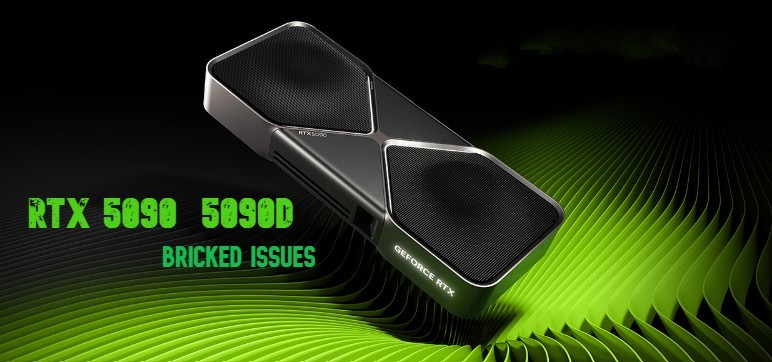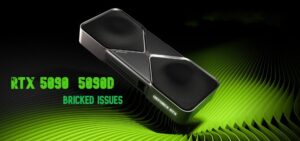Real Estate
Can You Prevent RTX 5090 and 5090D Bricked Issues?, Common Causes Behind RTX 5090 and 5090D Bricked Issues, Fixing Driver and Firmware Issues, How Faulty Software Updates Cause Bricking Problems, How to Troubleshoot Power Issues with Your GPU, Overclocking: How Pushing Limits Can Lead to Bricking, Power Surges and Hardware Failures: A Threat to Your RTX 5090, What Does "Bricked" Mean for RTX 5090 and 5090D?, What to Do If Your RTX 5090 or 5090D Is Bricked, When Should You Contact Customer Support for Bricked RTX 5090?
Lynn
0 Comments
RTX 5090 5090D Bricked Issues: Causes, Solutions, and Prevention
Introduction
The release of the RTX 5090 and RTX 5090D has brought excitement to the gaming and professional graphics community, offering exceptional performance, breathtaking visuals, and cutting-edge technology. However, some users have faced frustrating issues where their RTX 5090 and 5090D bricked issues graphics cards become “bricked, meaning the card becomes completely unresponsive and fails to function. Bricked issues can stem from a variety of causes, from software bugs to power surges, and can often lead to panic for users. In this article, we’ll explore what bricked issues are, why they happen, and how to troubleshoot and prevent them, ensuring your investment in high-end GPUs remains protected.
What Does “Bricked” Mean for RTX 5090 and 5090D?
When a graphics card, such as the RTX 5090 or 5090D, is described as “bricked,” it means that the card is no longer operational and appears as if it’s a useless piece of hardware, much like a brick. The GPU may not power on, may fail to initialize, or could cause the system to crash continuously. This typically happens due to severe errors in either the hardware or software, making it crucial for users to understand the underlying causes and potential fixes.
Common Causes Behind RTX 5090 and 5090D Bricked Issues

Bricking issues on the RTX 5090 and 5090D bricked issues can arise due to multiple factors. Overclocking, for instance, pushes the card’s hardware beyond its limits, which can result in overheating or voltage problems that may permanently damage the card. Additionally, software glitches such as corrupted drivers, problematic BIOS updates, or faulty firmware installations can contribute to these issues. Power surges or unstable power supplies may also damage the hardware, leading to failure.
How Faulty Software Updates Cause Bricking Problems
One of the leading causes of bricked issues for high-end graphics cards like the RTX 5090 and 5090D bricked issues is the failure of software updates, particularly BIOS or driver updates. When firmware or driver versions aren’t compatible with the hardware or contain bugs, it can cause the GPU to stop functioning. Users may find that after installing an update, their GPU refuses to power on or operate correctly, effectively rendering it unusable.
Power Surges and Hardware Failures: A Threat to Your RTX 5090
Power-related issues are another significant contributor to bricking. A power surge, or an unstable power supply unit (PSU), can cause irreparable damage to the delicate circuits within the RTX 5090 and 5090D bricked issues cards. Even a minor fluctuation in voltage can harm the GPU’s components, leading to an abrupt failure. Ensuring a stable and high-quality power source is essential to avoid such issues.
Overclocking: How Pushing Limits Can Lead to Bricking
Overclocking your RTX 5090 or 5090D for better performance can be tempting, but pushing the hardware too far without proper cooling can cause instability or overheating, which could permanently damage the card. If the temperature spikes or the power draw exceeds the GPU’s rated capacity, you risk bricking your card. It’s important to overclock carefully and keep a close eye on temperature levels to avoid such problems.
Can You Prevent RTX 5090 and 5090D Bricked Issues?
Yes, taking certain precautions can minimize the risk of bricking your RTX 5090 or 5090D. Regularly updating your drivers and firmware through official channels ensures that your card is operating with the most stable and compatible software. Additionally, avoid aggressive overclocking unless you have a proper cooling solution and ensure that your power supply unit is rated for high-end GPUs. Taking these basic steps will help you avoid most bricking issues.
What to Do If Your RTX 5090 or 5090D Is Bricked
If you discover that your RTX 5090 or 5090D is bricked, it’s important not to panic. Start by checking the power connections and ensuring that your PSU is functioning properly. If the card is unresponsive, try performing a hard reset, removing the GPU, and reconnecting it. You can also try rolling back to a previous driver or BIOS version to see if that resolves the issue. In more severe cases, you may need to perform a BIOS recovery or reach out to Nvidia for assistance.
Fixing Driver and Firmware Issues
Sometimes, the cause of bricking is a corrupted driver or a failed BIOS update. If you suspect this is the case, the first step is to reinstall the graphics card drivers using the official Nvidia website. You may also want to flash the BIOS using a recovery tool, which can restore the original firmware. Flashing the BIOS can be tricky, so make sure to follow step-by-step guides carefully.
How to Troubleshoot Power Issues with Your GPU
When facing power-related issues, start by confirming that your power supply unit (PSU) is capable of handling the RTX 5090’s requirements. Ensure that all power connectors are secure, especially the PCIe connectors, which are crucial for the GPU’s operation. If you have access to a different PSU, testing with that can help rule out PSU problems as the cause. Lastly, consider using a surge protector to prevent power spikes from damaging your hardware.
When Should You Contact Customer Support for a Bricked RTX 5090?
If you’ve followed troubleshooting steps without success, it’s time to contact Nvidia’s customer support or visit an authorized service center. They can help determine whether the card needs a repair, replacement, or further troubleshooting. If your card is still under warranty, Nvidia may replace the defective GPU or provide other solutions.
Is the RTX 5090 or 5090D Covered for Bricked Issues Under Warranty?
The RTX 5090 and 5090D bricked issues typically come with a manufacturer’s warranty, covering defects in materials and workmanship. However, if bricking occurs due to user-induced issues like overclocking, third-party BIOS mods, or power surges, it may not be covered. Always review the warranty terms before attempting any repairs on your own or seeking a replacement.
Best Practices for Cooling Your RTX 5090 and 5090D to Prevent Bricking
Keeping your RTX RTX 5090 5090D Bricked Issues cool is one of the most effective ways to prevent overheating and ensure its longevity. Make sure your case has adequate airflow and that your GPU is properly ventilated. Adding additional case fans or using a liquid cooling system for your GPU can help maintain stable temperatures, especially if you are running demanding applications or gaming for extended periods.
Monitoring GPU Health and Performance to Avoid Bricking
Regularly monitoring the health and performance of your RTX 5090 or 5090D can help you spot any signs of trouble early. Tools like MSI Afterburner or HWMonitor allow you to keep an eye on temperature levels, fan speeds, and voltage fluctuations. Monitoring software can alert you when your GPU is getting too hot or when it’s drawing more power than it should, allowing you to take action before it leads to permanent damage.
Final Thoughts
The RTX 5090 and 5090D bricked issues are exceptional pieces of technology, offering unmatched performance for gaming and professional work. However, like any advanced piece of hardware, they require care and attention to prevent issues like bricking. By ensuring stable power, using proper cooling solutions, and regularly updating drivers and firmware, you can reduce the risk of bricking and enjoy your GPU for years to come. Should issues arise, early detection and troubleshooting can often resolve problems before they become irreparable. If all else fails, Nvidia support is there to assist with repairs or replacements under warranty.













Post Comment